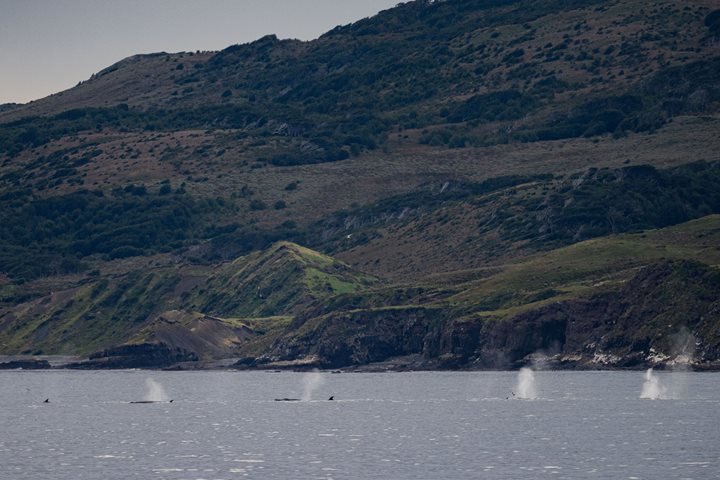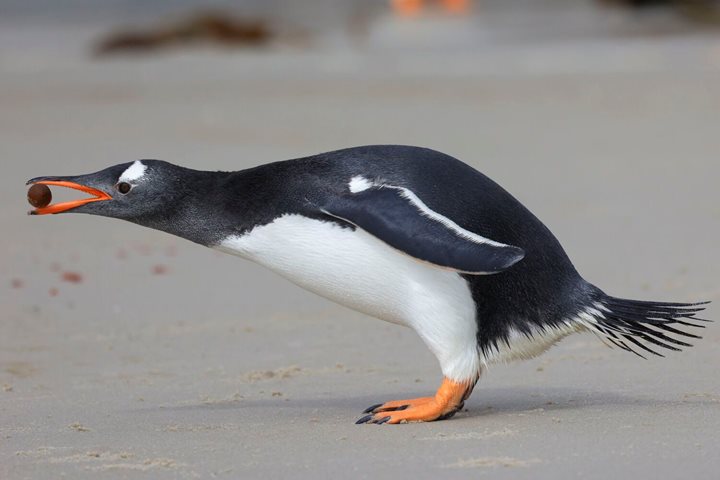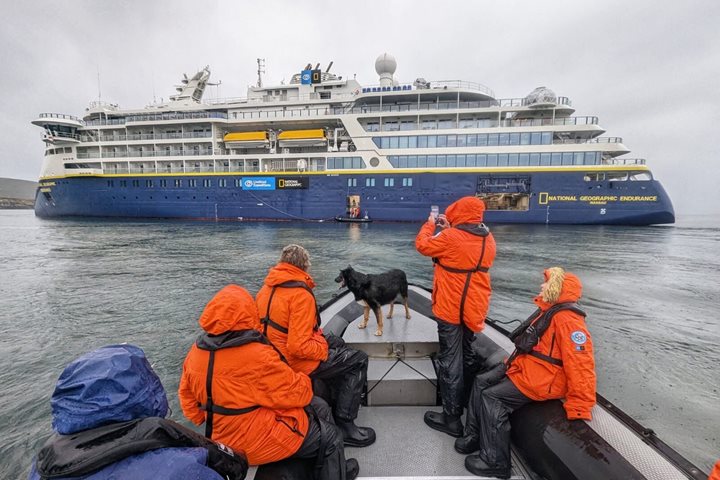Ian: There are some mornings that just start out so pleasantly that words can’t capture it. How can you accurately describe and impart the way brisk sea air whips up the waves or the warmth of the much welcome sun greeting our faces? Eager to set out for adventure we landed on the picturesque Caribbean-like white sand beach with turquoise waters of Carcass Island. We were greeted by a multitude of birds, so diverse it would be impossible to name them all.
Tom: National Geographic Orion arrived at Carcass Island at 0830. The island is owned by Rob and Lorraine McGill. The wind speed upon arrival was 20 knots, with gusts of 35 knots. The air temperature was 17° C (63° F). Most people made a hike of 5.3 km (3.2 mi) from Leopard Beach to The Settlement. During the hike, we saw Magellanic penguins, gentoo penguins, upland geese, kelp geese, ruddy-headed geese, flightless steamer ducks, tussock (tussac) birds, dark-faced ground tyrants, Falkland thrushes, striated caracaras, two-banded plovers, and Magellanic oystercatchers. At The Settlement, we saw Patagonian crested ducks, kelp geese, upland geese, Falkland thrushes, striated caracaras, tussock (tussac) birds, and black-crowned night herons. While most people were hiking, National Geographic Orion shifted to the inner bay and anchored off The Settlement.
Ian: Our energetic jaunt through fantastically flowering Falkland Island blue grass led us to the lovely local residents of the island, who graciously welcomed us into their home where a sumptuous spread of sweets and piping hot tea awaited. Scones with fresh cream and jam, lammingtons, decorated cookies, cakes, biscuits, and more! Each morsel a treat to the senses that one simply wanted to sample them all. Buoyed by our sugary snacks we clambered into the Zodiacs and headed to the ship for lunch.
Tom: At the settlement, we were offered a traditional Farmer’s Tea.
Ian: Our afternoon and final landing of the trip on New Island was somewhat bittersweet as we traversed up an undulating tussock grass flanked path so lovely we paid no heed to the distance, not knowing or caring how long it took us. Our stunning destination presented us with our eighth penguin species, the gregarious and aptly-named rockhopper, along with an indeterminate number of black browed albatrosses, and the comparatively ungainly shags. The swirling swarms of circling birds swooping about overhead provided a constant visual show that couldn’t be rivaled.
Tom: National Geographic Orion arrived at New Island at 1545. The wind was 35 knots, gusting to 47 knots, out of the northwest. The air temperature was 16° C (61° F). The island consists of two former privately-owned properties now jointly managed by the New Island Conservation Trust. We offered a walk of 1.39 km (0.86 mile), which averaged 16 minutes, leading from the landing beach across to the windward side of the island. The geology is composed of high, rugged sandstone cliffs. Here, we observed a joint colony of three species of nesting birds that consisted of 458 pairs of rockhopper penguins, 216 pairs of black-browed albatrosses, and 623 pairs of king shags. Everyone was back aboard the vessel by 1752.
Ian: Back onboard before dinner we enjoyed our final recap and comparing perspectives with our fellow shipmates.


.jpg?width=106&height=85&mode=crop&scale=both&quality=50)



